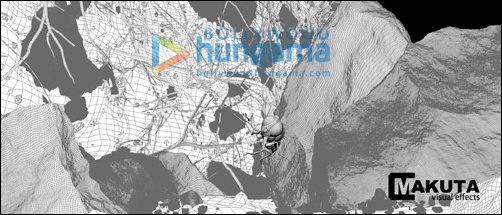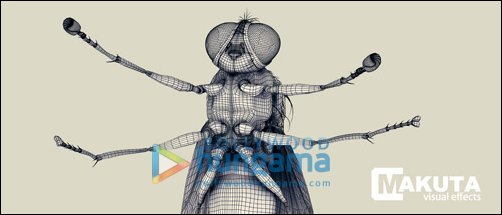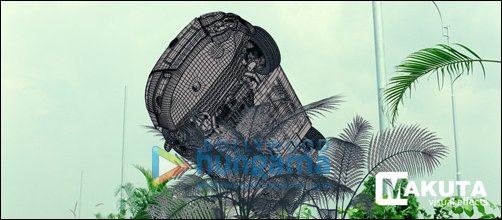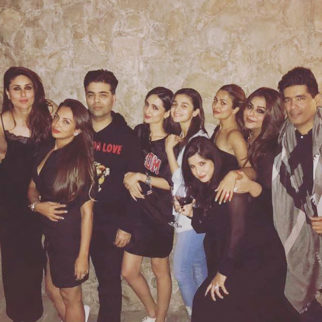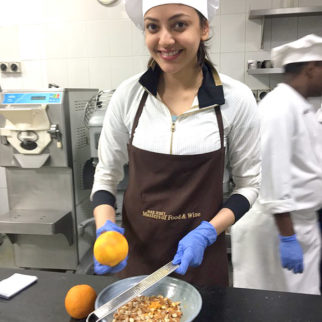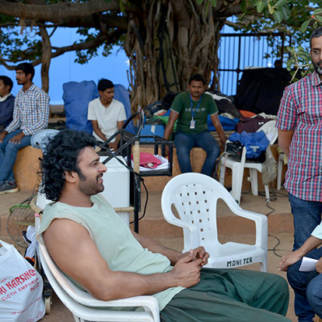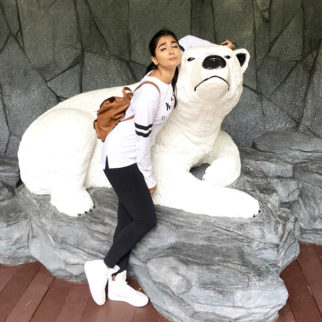Hyderabad-based Makuta VFX delivers visual effects of Makkhi
-
 Makkhi, the Hindi version of S.S. Rajamouli’s latest south Indian blockbuster Eega, garnered some rave reviews from both the critics and audiences. The film is being lauded for its incredible CGI and visual effects story telling ability, in which the protagonist of the movie is reincarnated as a house-fly to avenge his death. Adel Adili, Read More">Read More
Makkhi, the Hindi version of S.S. Rajamouli’s latest south Indian blockbuster Eega, garnered some rave reviews from both the critics and audiences. The film is being lauded for its incredible CGI and visual effects story telling ability, in which the protagonist of the movie is reincarnated as a house-fly to avenge his death. Adel Adili, Read More">Read MoreMakkhi, the Hindi version of S.S. Rajamouli's latest south Indian blockbuster Eega, garnered some rave reviews from both the critics and audiences. The film is being lauded for its incredible CGI and visual effects story telling ability, in which the protagonist of the movie is reincarnated as a house-fly to avenge his death. Adel Adili, Pete Draper and R.C. Kamalakannan, the original co-founders of Hyderabad-based Makuta VFX (incorporated in the USA), headed a team of around 100 artists to work round the clock to deliver the CGI and VFX process of the film. Bollywood Hungama's Philip Bode gets Pete and Adel to talk about magnitude of digital filmmaking work involved, character animation, filling in the gaps and the challenges that gave cinematic wings to Makkhi.

-
 “We managed to push the scene’s polygon count to over 5.3 billion” The trench episode was one of the most challenging sequences, with the fly being re-born into a large-scale Grand Canyon type environment. Initially, the crew tried to film the angles with live water and a physical set although, Read More">due to constraints and limitationsRead More
“We managed to push the scene’s polygon count to over 5.3 billion” The trench episode was one of the most challenging sequences, with the fly being re-born into a large-scale Grand Canyon type environment. Initially, the crew tried to film the angles with live water and a physical set although, Read More">due to constraints and limitationsRead More"We managed to push the scene's polygon count to over 5.3 billion"
The trench episode was one of the most challenging sequences, with the fly being re-born into a large-scale Grand Canyon type environment. Initially, the crew tried to film the angles with live water and a physical set although, due to constraints and limitations of the cameras, they could not achieve the angles required for the sequence. The decision was then made to do the entire sequence digitally, which was an enormous task. The amount of detail in the environment was colossal, every single grain of sand, dirt, rock, root and leaf needed to be viewed in high detail, the water simulations requiring weeks to compute due to the high level of detailing and environment interaction complexities. A normal scene has several million polygons within a shot, however, this particular sequence, thanks to a system Makuta developed and some intuitive caching of data, we managed to push the scene's polygon count to over 5.3 billion. Something even the developers of the software were amazed at."
Talking about the series of tech involved Pete and Adel conclude, "Makuta used numerous software products to create the effects work for Eega - 3ds Max for modeling, animation, dynamics, lighting and rendering, Maya for character animation and partial rendering work, Mudbox for digital sculpting, Photoshop for texture work and matte-painting, Digital Fusion and Nuke for matte-painting and compositing. In addition, Makuta has its own dedicated render farm for rendering the 2000-plus shots that was required for this feature film. -
 “A lot of elements had to be replicated in CG” Due to the complexities and handling of jobs back at the studio, there were two principal VFX Supervisors working on set and/or at the studio simultaneously. We would advise the director on how to get specific shots as he required, Read More">sometimes having to think onRead More
“A lot of elements had to be replicated in CG” Due to the complexities and handling of jobs back at the studio, there were two principal VFX Supervisors working on set and/or at the studio simultaneously. We would advise the director on how to get specific shots as he required, Read More">sometimes having to think onRead More"A lot of elements had to be replicated in CG"
Due to the complexities and handling of jobs back at the studio, there were two principal VFX Supervisors working on set and/or at the studio simultaneously. We would advise the director on how to get specific shots as he required, sometimes having to think on our feet as the shoot was occasionally dynamic. Makuta pre-visualized and storyboarded a lot of the feature film, but when it came to filming, things had a tendency to change. The shots we thought could be shot live practically became impossible because of physical aspects; the lenses had a large diameter so getting close to objects or surfaces was difficult. The probe lenses we used had to be perfectly static, or else it would appear like an earthquake occurred with just the slightest shudder. Therefore, a lot of elements had to be replicated in CG with us having to determine passes, lighting information, set notes etc., and think of solutions to problems in a heartbeat, while also anticipating issues that may come up later on. It was a challenging shoot to work on but good nonetheless.
-
 “We went back to the trusty 35mm film” Originally, the idea was to shoot the film using a Canon 5D over a few months due to the original low budget. However, as the script progressed and the production budget increased, Read More">the next idea was to shoot digitally. We tested numerous formats and zeroed in onRead More
“We went back to the trusty 35mm film” Originally, the idea was to shoot the film using a Canon 5D over a few months due to the original low budget. However, as the script progressed and the production budget increased, Read More">the next idea was to shoot digitally. We tested numerous formats and zeroed in onRead More"We went back to the trusty 35mm film"
Originally, the idea was to shoot the film using a Canon 5D over a few months due to the original low budget. However, as the script progressed and the production budget increased, the next idea was to shoot digitally. We tested numerous formats and zeroed in on the Arri Alexa, although at that point in time they had not locked their RAW format. Two months prior to the principal photography starting, it was deemed too big of a risk to take, so we went back to the trusty 35mm film. Everyone related to the handling of the stock were involved in this process; the DOP and VFX supervisor(s) to comment on the quality, data handling and storage, all had viable inputs. The responsibility of the Visual Effects Supervisor was to liaise with the director, advice on shooting methods and sequences and to be able to collate all of the required data for the shoot, noting down differences on a take by take basis. If this information is accurately taken, then replicating it back at the studio and passing the desired information to each department is fundamental, making the process easier overall.
-
 “With some trepidation we replied with a resounding ‘Yes it can be done'” Initially, the discussion Makuta had with S.S. Rajamouli was ‘is it possible?’ We just finished Maryada Rammana, Read More">the Telugu version of Son of Sardaar with him and the original conversation turned to this quick experimental feature that he was going to do;Read More
“With some trepidation we replied with a resounding ‘Yes it can be done'” Initially, the discussion Makuta had with S.S. Rajamouli was ‘is it possible?’ We just finished Maryada Rammana, Read More">the Telugu version of Son of Sardaar with him and the original conversation turned to this quick experimental feature that he was going to do;Read More"With some trepidation we replied with a resounding 'Yes it can be done'"
Initially, the discussion Makuta had with S.S. Rajamouli was 'is it possible?' We just finished Maryada Rammana, the Telugu version of Son of Sardaar with him and the original conversation turned to this quick experimental feature that he was going to do; this was a short footstep for him to play with some recent technology and see if a feature film could be rendered out in this way. The budget was exceptionally low at this time, so the visual effects were straight-forward, however as the script advanced and the budget increased, the treatment turned into a larger scale job which needed a significant amount of advanced effects work. With some trepidation we replied with a resounding 'yes it can be done'. However, at that time, the issues that we would encounter later such as physically getting the back-plates and angles required for the shots, were not known. This was not due to visual effects but more because of the limitations of the physical camera rig setups on set; visual effects had to fill the gaps, which increased our workload and shot count substantially.
"Finally delivered the last shot of the South Indian version Eega in late June 2012"
From the initial brainstorming sessions with the director, right through the character design sketches and storyboarding, Makuta started working on the initial treatment of the feature film in late 2010. It had been an extensive process with a lot of development and pre-production which was required for the film prior to shooting a single roll of film. We finally delivered the last shot of the South Indian version Eega in late June 2012 and the last shot of the Hindi version Makkhi delivered the following September due to additional corrections for version tailoring; we had some additional tweaks to shots that the director did not like with the Telugu version.


